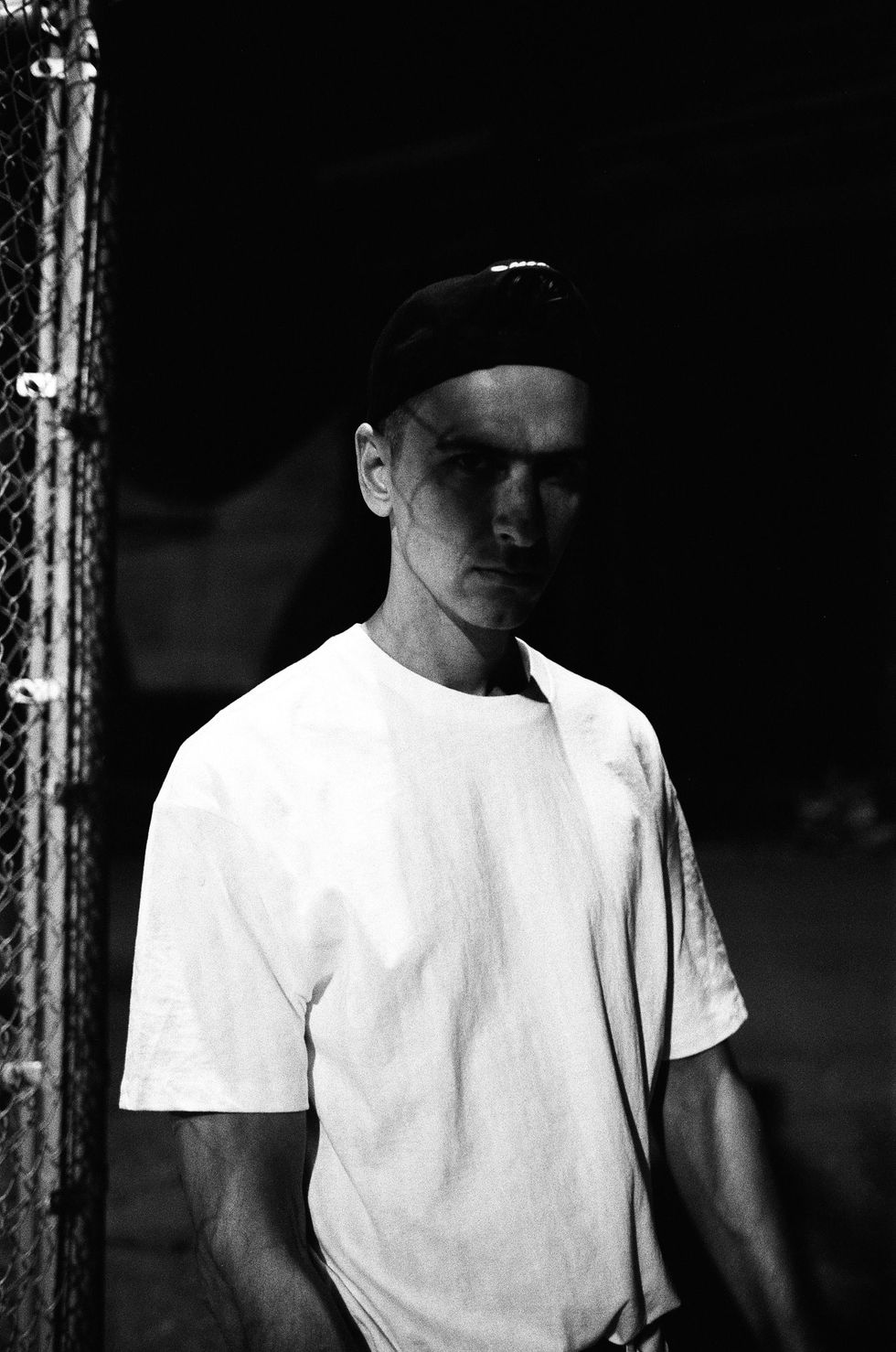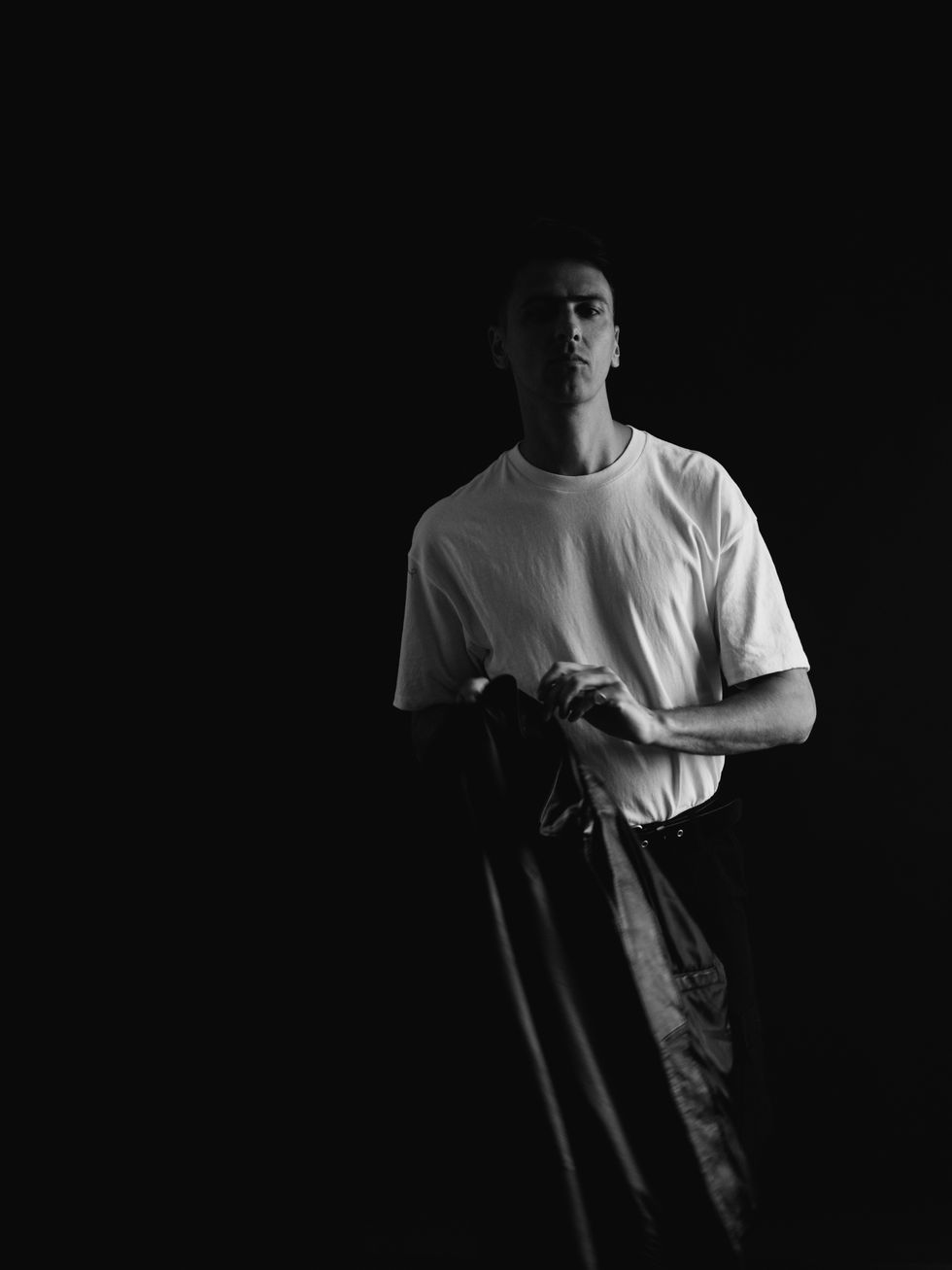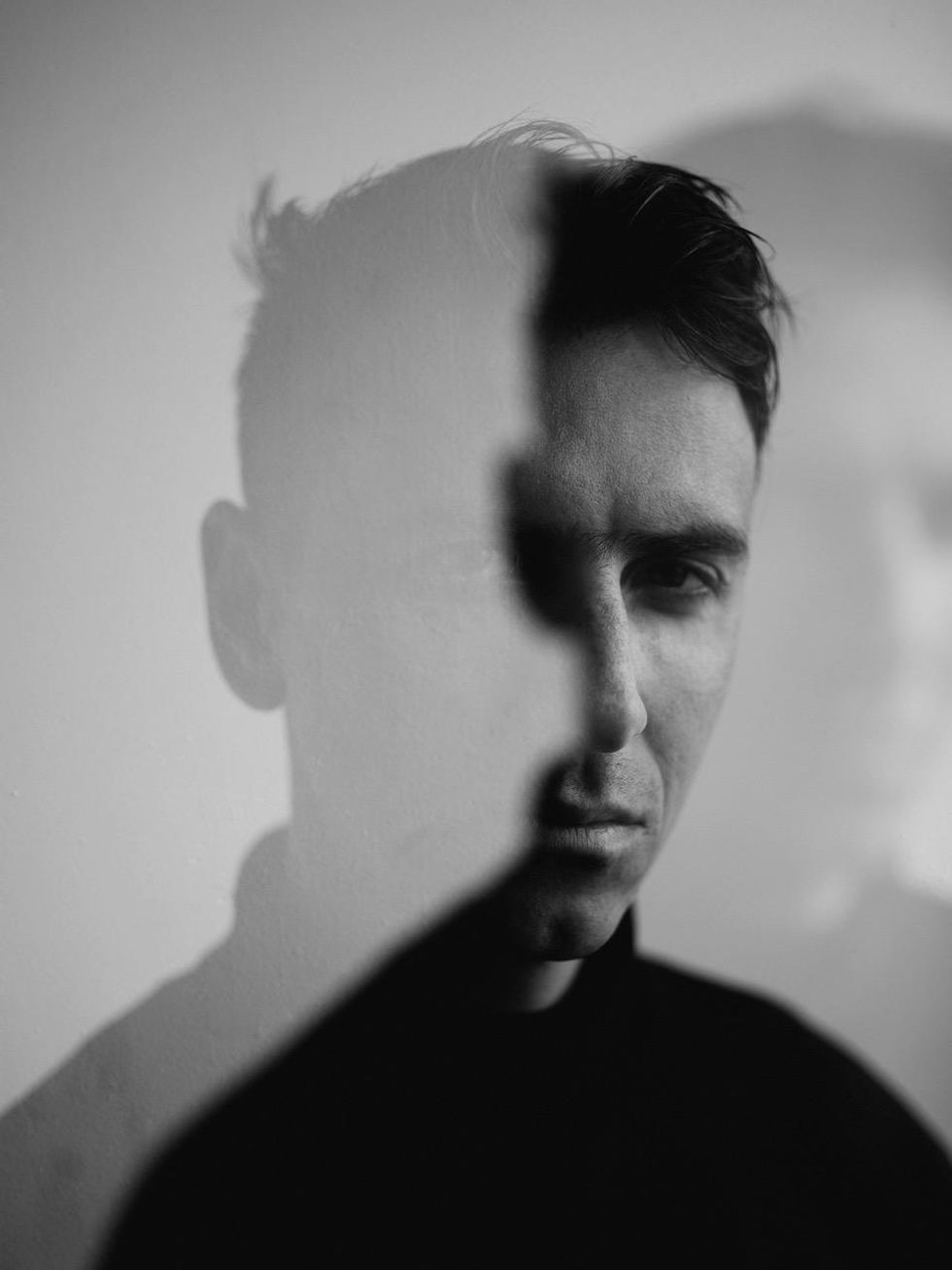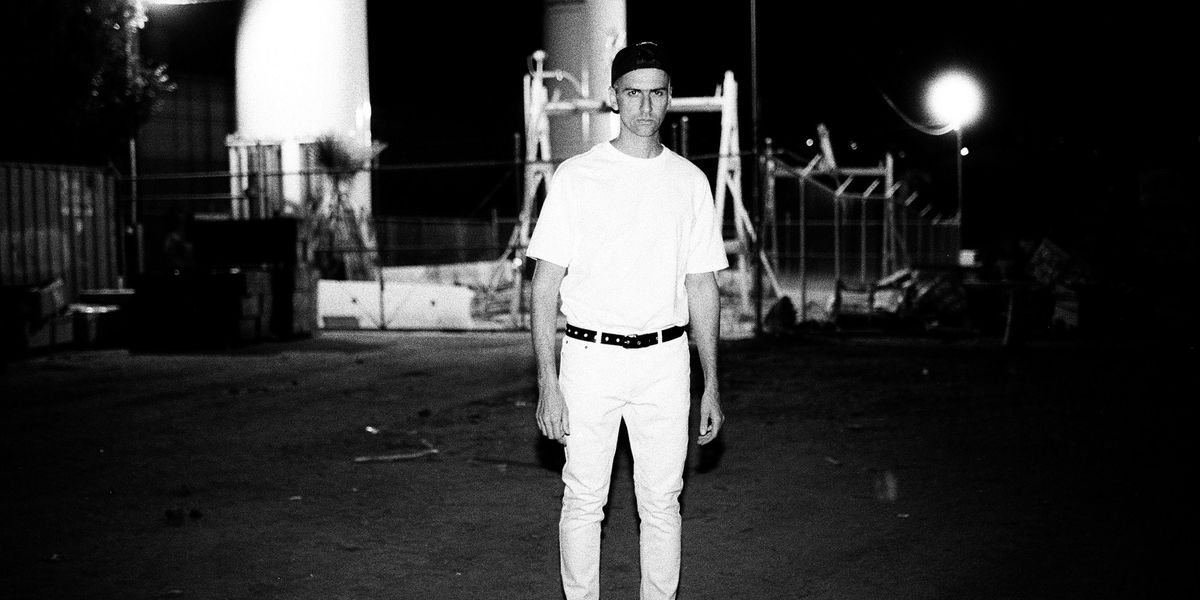From playing a crowd-pleasing set on the main stage of a major EDM festival one day to holding it down behind the decks at Berghain the next, producing tracks for artists like A$AP Rocky, Lady Gaga, Frank Ocean, Mark Ronson and then in the same breath quietly putting out understated house tracks under a pseudonym, German-Iraqi producer Alex Ridha, better known as Boys Noize, has made a career out of seamlessly fluctuating from one extreme to another.
Whether he's churning out loud turbo-charged electro or sweaty wall-rattling techno or smoking swagger rap beats or drip a balled in gauzy layers of synth, over the course of the past two decades, Boys Noize has proven himself to be nothing short of a production powerhouse with an incredible amount of versatility and a distinct musical identity.
Ridha's fifth studio album as Boys Noize, +/- (pronounced: "polarity"), sees the producer drawing on years of sonic experimentation, exploration and tech savvy, distilling it into a refreshing and eclectic album, thriving on unexpected contrasts and fertile grey areas.
There is a little bit of everything tucked within +/-'s 15 song tracklist, from hard-hitting industrial techno found in tracks like the adrenaline pumping hiss of "Xpress Yourself" or the siren wail of "Sperm" to some of the softer indie dance leaning cuts like Vinson's haunting ballad "Act9" or the infectious groove of the ABRA-featuring "Affection."
But where the record truly shines is when the lines between them all begin to blur. Take for instance, "Nude" featuring irreverent Estonian rapper Tommy Cash, with its bright sparkling synths and ravey breaks butting up against an absolutely relentless hard techno drop, plunging the listener from a state of dreamy euphoria into a dark blood-pumping onslaught of kicks and frenzied chirps before surfacing for air once again.
And this extends beyond the sonic juxtaposition of hard and soft, light and dark, with more experimental curiosities such as the eerie moaning chorus on gothic techno banger "IU" sitting right alongside more pop-structured cuts like the acid-tinged disco groovefest anchored by Scissor Sisters alum, Jakes Shears, "All I Want." (How Rico Nasty's "Girl Crush" isn't being mercilessly played to death in every queer club, party and playlist right now is beyond me.)
Ahead of the PAPER premiere of Boys Noize's fifth studio album, +/-, we caught up with the producer to talk about the inspirations, its evolution and that one time Lady Gaga spilled water all over one of his synthesizers.
What was the inspiration behind the album?
First, there's always the sound. I usually look out for new machines, new technology, new plugins or ways to create new sounds. I had that moment in 2017, where I discovered this one module and I created a sound that I basically never heard before. I recorded a few sequences with it and that was basically the starting point of the song called "Greenpoint," which was actually recorded in Greenpoint, New York. For me, it was something like George Michael meets Nine Inch Nails and it definitely gave me the idea for what my next sound could be and what my next kind of style will be.
There was another one also entirely made with the modular system, which I became obsessed over the past few years, and it became the song "Close." I had this first opening sequence, and it sounded a little industrial, but then I was thinking about "how can I break it?" Then I made "Girl Crush" and it became more and more clear what I wanted to do. My main inspiration always comes from the sound and because I created all these sounds that I didn't hear before, or at least in certain contexts. Obviously, there's the music I play as a DJ; I look out for new music every week, or buy records and receive demos. So I am also very much inspired by my DJing and everything around it. I keep switching it up and I keep relearning things, and that's what's drives my inspiration the most actually.
What does "polarity" mean to you?
For me, "polarity" means I need to look out for what's in the middle. Because you have these very opposite sides, you have this division, the black and the white. You can draw that to so many aspects around your life and the way we live, the way we interact, the way we react, the way we love and everything. There's so many things that are quite polar. It means I need to find that magic spot that that starts to trigger my fantasy about what would happen if this and that side could meet. It's not so easy, but it's definitely become my lifelong mission.
When I look at myself as a DJ, or as a producer, my emotions get usually triggered by something that opens up my fantasy about this world that I haven't quite understood yet. We have house and techno, and I was born in Hamburg and it was all about house music. In Berlin, it was all about rave and techno. When I started to DJ there were clear sides, but I love to bridge those things. I was always interested in merging things. Let's say I make a techno track or beat, I always start to think, "What rapper could go over this?" Or if I could turn that into something more melodic with a vocal? With Polarity, this is basically the first time I was able to find the people that are open enough to explore that musical fantasy and go down with me, so that's been a very satisfying moment. It's been a long journey to get to that point where I'm able to bring someone like Rico Nasty over an industrial techno beat or bring someone like Kelsey Lu, who's doing a bit more classical music, to record over a song like, "Love & Validation."
How did that Rico Nasty collab come about?
I came across one of her early songs and to me it was one of the freshest. I'm not too up to date with rap because it moves so quick. I'm more into the stuff I do, but when I heard her stuff, I was like, "Wow, this is really refreshing." I haven't seen someone like her making music like that for a while, so I reached out. Funny enough, a friend of mine produces her music, that I produced with as well, and we met up a few times.
She's a great example because she's obviously doing rap and trap and metal and stuff, and I played her this really slow techno industrial beat, and she was feeling it right away. That to me was really refreshing because I've tried this type of collaboration for a few years and it never happens because most of the artists that are known for certain genres keep it in their lane. Seeing her being so open-minded and loving what I was playing her, there was a great energy from the beginning. I think that song is a good example of the idea of my album. The polarity, the really big contrasts, but creating something new out of that. That to me was the main motivation.
Who came up with the hook for that?
It was her, it was all her.

Your last album, Mayday, covered a lot of different genres and styles under one umbrella. This one, to me, feels more in that heart industrial techno sound throughout.
Mayday was really about the nonconformist idea of an album where you have all these different styles and they all live together in a world. For the past four years, I always look for new sounds that I haven't used before or haven't put together or created yet. But now it's gone one step further where I've started to create a whole new method of how to create the sound. So when producers are trying to recreate the sound, they have to create the way I make it first. I really got into the modular world of making sounds. That was so inspiring for me. This album definitely reflects more of this uncommon sound. It does sound more industrial because a lot of the stuff I do with the modular system ends up just sounding more industrial and raw.
How did all the collaborations and features come about on this album?
Every collaboration on my album is the first time I met someone that enjoys the music that is presented just as much as I do and have the imagination to make a song like that. It's really difficult to do that, especially with singers who are more comfortable with structures of pop music, which never quite excited me anyways. It's nice because every recording happened together in a room, every feature, we've connected on a human level and had a lot of fun.
With Kelsey Lu, we've had magical moments in the studio where we both laugh and get goose bombs. This is so important for me to create music that I truly feel emotionally connected to. When I work with someone, I need to feel that energy in the room and I need that exchange. The artists that are featured on the record are friends and musicians I love to work with, people that I'm a fan of already. Take the song "Act9," Vinson has never recorded his voice ever before, never written a song ever before, and he's got this fantastic gift in his voice and writing that we discovered together.
How has the album changed or evolved over time?
The album has come together over the past few years. I really took my time to record a lot of music, so the first recording started in 2017 over '18 and '19 even. A lot of times I would record something and then leave it for a few weeks, a few months and then revisit it, working on something that I feel sounds the most special. So basically everything you hear on the album are my favorite things that I've done in the past few years.
Style-wise it started with all very slow industrial sounding ones and then I started to think, "I need a few more fast ones for my set." I did the opposite with the super fast ones. I did "IU" and "Xpress Yourself" and it started to balance out in a nice way. Over that whole period, the idea about plus/ minus, a polarity, started to get more clear. I let the songs breath for a while until I decided to put them out and on an album like this. I go in quite deep in the production, every single sound has to have a reason to exist. They get the more in-depth treatment. Whereas, if you listen to my Strictly Raw albums, those stay in this kind of DJ tool world, easy for me to play, maybe not for everybody to play, but more meant to be in this raw production state.

Outside of your own productions, you've worked with a wide range of artists over the past few years. You've collaborated with A$AP Rocky, had a Grammy-nominated track with Skrillex and Ty Dolla $ign, and even did an EP with Virgil Abloh. For lack of a better question, what's it like being you?
I'm really glad that I can do all that and finally people aren't too confused by it. It definitely took a few years to get that message across. Here's a good example: when I DJ and the party's going well, I'm always secretly thinking, "How can I fuck this up?" but still in a party way. I'm like, "What can I do to completely break it?" and that's a thing that plays into me as a producer or production or what I want to do next, as well.
But being able to produce a Rocky record is incredible. Again, he'd been coming to Berlin and I was the guy in Berlin. I'm super happy I can do that because, obviously, I've kept it more straightforward in the Boys Noize sound, and I hadn't gone too much out of that niche, even though I've tried to. I'm not making straight techno records, even though when I DJ, I play straight techno. It took a long time to have the people's mindset be where the music I do as a producer might not necessarily reflect what I do as a DJ.
Looking back now, when all these indie remixes come up, it was the same thing. For instance, I just saw someone posting the Feist remix. That brought me back, I was like, "Yeah, that was a folk record." I remember back then I was telling in my interviews the same thing, where I was always more excited to remix something that has nothing to do with electronic music and try to bring that into our world. That's the excitement to me for music. Why would I make the records that I play because there's already so many good techno tracks, good industrial, electro, house. My main motivation is always how can I take what I love so much and what I play as a DJ, but maybe there's something I can do to fuck it up and bring it into a whole different thing.
Along these same lines, you recently worked with Lady Gaga on a bit of Chromatica. How did that come about?
It was a classic LA moment where I met up with an older friend of mine who's become a pretty known pop producer, Bloodpop. He did a remix for me in 2012 for the Snoop [Dog] record I put out. We've kept in touch over the years, so every time I'm in LA I see him. I played him some of my album stuff, I played him "Greenpoint," actually, and another one, and he was like, "Let me send this to Gaga." I didn't know he was involved in any of that. He texted her while I was around and we got a text back five minutes later and she's like, "I want to meet this guy." She loved the stuff.
The next day I sat next to her in the studio, and it was really bizarre but beautiful because she's such a cool human being. She brought out things I would never expect from her, like she asked me if I know Surgeon, and I'm like, "You're talking about Surgeon!" She brought him on tour to open up for her live shows and I didn't know that. There was a funny moment where I brought my small modular case and she was like, "Whoa, look at this," and she was really interested and, with the excitement, she spilled water over it. We cleaned it and all that stuff, but we wrote a few songs. That was a really nice, positive thing because, obviously, I was not too keen to get into the pop world again after I tried it a little bit around 2010. I felt like I'm not the perfect person because you've got to have elbows in that game. You spend a lot of time with random people writing random songs, hoping. I'd rather do five new DJ tools and know I'm going to release them rather than making 10 songs that will never come out because of some weird political industry reasons. Gaga was so cool and that made me really be hopeful about the music we did.

I know you worked with Eric Timothy Carlson on the artwork and visual language of the album. How did you two end up working together on this project and what sort of concepts were you two working with on +/-?
I've been quite a long fan of Eric Timothy Carson's work. I discovered his designs and art through these Bon Iver album covers and around the same time we personally met through Justin from Bon Iver from these 37d03d festivals he's done. I was like the only electronic producer/ DJ there. So I met Eric there and then I went to New York to check out his galleries. I just had to ask him; I mean, I honestly thought he wouldn't do it because he's not really doing anything outside of money, or for other artists or musicians. He's got a lot of work on his own, but I'm happy he accepted it. We've gone super deep and I'm quite overwhelmed by how much he's created. It's really insane. We probably went through all aspects of polarity, the world with magnetic fields, Yin and Yang, the caduceus, etc. We've created this system of symbols; every song has its own glyph that is paired with a version of the +/- design. I think it's the most incredible art I've ever had for any of my albums.
What do you hope comes across to people on this album?
If you're someone that has been following my productions for a long time, I hope it's something refreshing, exciting and unexpected. Throughout the album process, I've had multiple times where I thought, "Why don't I just put together my best 10 technical tracks?'" But, for me, the excitement is really about pushing myself and seeing what's there. The question is like, "What can I contribute to electronic music?" Because everything sort of exists.There's so many great things and +/- hopefully gives you a little fresh kind of thing and makes you smile, cry. It gets quite emotional towards the end of the album, not quite euphoric, let's say that's a better word. On the production side, I obviously try to impress the other producers that I adore. When they hear it, I hope they think it sounds sick. That's usually one of my main goals. But, as a fan, if you're someone that follows me, I hope it's something fresh and gives you some good emotions.
Photography: Shane McCauley
- Brooke Candy Drops "FMU" Video - PAPER ›
- Shygirl and Slowthai Team Up on "BDE" - PAPER ›
- ABRA, Playboi Carti & Boys Noize — "Unlock It" - PAPER ›
- Boys Noize Talks 'Challengers' Soundtrack ›
